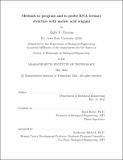| dc.description.abstract | Biological structure determination has revolutionized mechanistic understandings, nanotechnology, and drug design. Despite advances in structural determination technologies, from nuclear magnetic resonance to cryo-electron microscopy (cryo-EM), one class of biomolecules has resisted 3D structure characterization. RNA, particularly larger RNAs, often dynamically adopt multiple conformations in a structural ensemble, and this heterogeneity has made 3D structure determination challenging through conventional techniques.
In this thesis, I investigated two avenues for improving RNA 3D structure determination, both leveraging the nanoscale programmability of nucleic acid origami. Nucleic acid origami generally involves folding one long single-stranded nucleic acid, the scaffold, into a target geometry via hybridization with short oligonucleotide "staples." First, we expanded the geometric space accessible to 3D wireframe DNA-scaffolded origami with edges composed of two helix bundles, optimizing folding conditions and crossover design and analyzing the final folded 3D structures, for a new design algorithm. I designed a tetrahedral wireframe DNA origami to capture an engineered tRNA via hybridization at three sites. For this complex, I verified stable, cooperative binding, and characterized the 3D structure with cryo-EM, which confirmed binding at all three sites and yielded a 17-Å resolution reconstruction of the tRNA. I also outlined a high-throughput workflow to probe the unknown tertiary structure of a target RNA with varied designs of DNA origami. Additionally, I studied the design of 3D wireframe RNA-scaffolded origami, characterizing the folded structure for several crossover schemes to evaluate how best to accommodate the A-form helical geometry of RNA for robust designs. The resulting algorithm for designing RNA-scaffolded polyhedra enables precise, covalent anchoring of a target RNA fragment onto a wireframe polyhedra. I tested this anchoring approach to attach a 232-nt HIV-1 RNA fragment to an RNA-scaffolded pentagonal bipyramid as a method to improve cryo-EM characterization. The particles folded into the expected pentagonal bipyramidal geometries, and cryo-EM micrographs suggested anchored target RNA, but the design and data analysis need further refinement to determine a 3D structure for the anchored RNA fragment. These studies together represent proofs-of-concept for stabilizing RNA structures on nucleic acid origami, enabled by the expansion of origami design. | |
